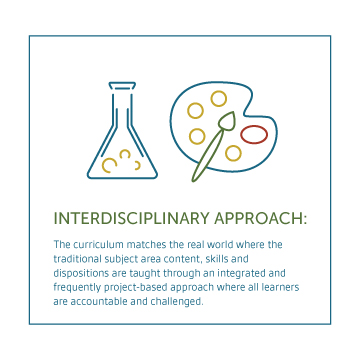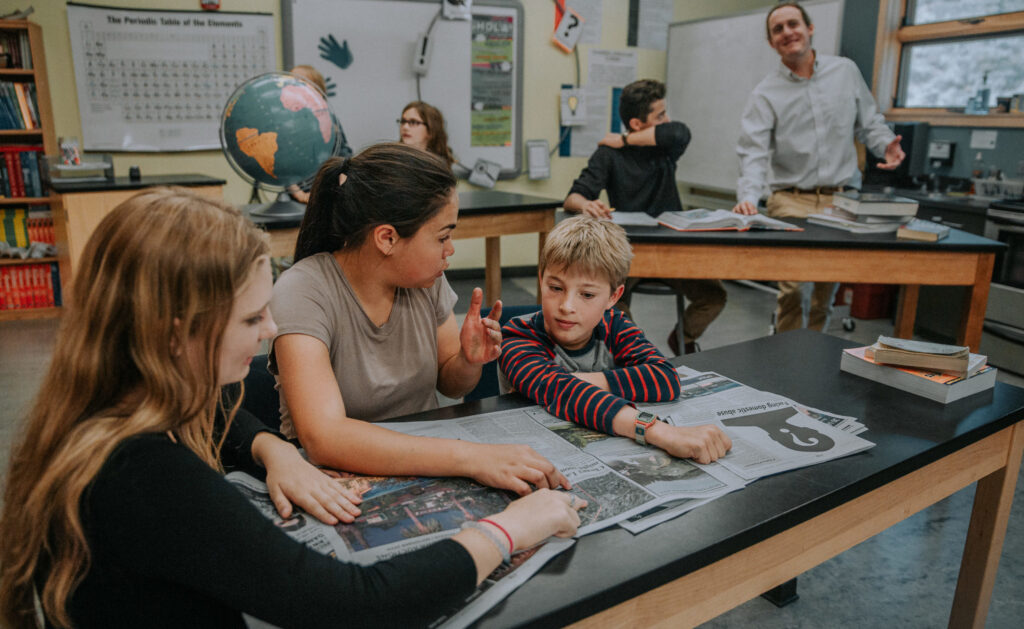“Place can be used not only as a starting point but also as a connector to bring coherence to a disconnected curriculum as students prepare for the world beyond school.”
-An excerpt from Chapter 7 of The Power of Place by Tom Vander Ark, Emily Liebtag, and Nate McClennen
We’re continuing our Diving into Place-Based Education series with a third installment focused on how an interdisciplinary approach strengthens learning.
Picture the scene. Elementary students in Columbia, Missouri learn that local native bee populations are in decline and wonder what they might do to help. Their teacher invites local experts to visit the class and the students grow in their understanding of bee biology and habitat needs. The new knowledge furthers their motivation to act. Science pivots to engineering as students identify constructing ‘bee hotels’ as a practical way to support pollinators and prototype design gets underway. The project culminates with a public speaking twist as students share their work with the community and distribute ‘bee hotels’ around the region.

Harnessing student motivation is easy when they are pursuing topics that interest them. And thoroughly investigating a topic generally spans disciplinary boundaries. This is the secret sauce of an interdisciplinary approach, a core principle of place-based education.
Recognizing the Power of an Interdisciplinary Approach
Communities are inherently interdisciplinary. Think about the city or town you currently call home. Understanding that area requires more than just knowledge of its economic drivers or cultural history. Weather patterns, soil type, local government, and everything in between influence how that community functions, its most valuable assets, and what challenges it is likely to face. Classrooms have traditionally reflected a more segmented approach, with math scheduled at one time, science after that, and so on. 
This structure has merits, particularly with regard to mastering basic skills of literacy and numeracy, but isolating subject areas also comes with constraints. Limiting opportunities for students to build connections across disciplines can make learning experiences shallow. For example, if students are studying wolves in their science class in a way that focuses exclusively on wolf biology, key opportunities to integrate multiple perspectives related to the significance of wolves through a social studies lens are missed and students don’t gain an understanding of the additional impacts of legislation and public opinion on wolf populations.
Building Interdisciplinary Learning from the Ground Up
 While recognizing student interest in a topic is often where interdisciplinary projects begin, teachers can play an instrumental role by bringing attention to a need and inviting students to dream up a solution. That’s how it happened for Javier Reyes, a bilingual teacher at Central Intermediate School in Monmouth, Illinois. While meeting with a new family, Javier noticed how surprised they were to learn about all the great things to do in the area. As non-English speakers, they lacked easy access to this information. When Javier asked his sixth-grade students if they wanted to do something about this problem, they responded with an enthusiastic, “Yes!”
While recognizing student interest in a topic is often where interdisciplinary projects begin, teachers can play an instrumental role by bringing attention to a need and inviting students to dream up a solution. That’s how it happened for Javier Reyes, a bilingual teacher at Central Intermediate School in Monmouth, Illinois. While meeting with a new family, Javier noticed how surprised they were to learn about all the great things to do in the area. As non-English speakers, they lacked easy access to this information. When Javier asked his sixth-grade students if they wanted to do something about this problem, they responded with an enthusiastic, “Yes!”
After several rounds of brainstorming, the students settled on the idea of developing a blog in Spanish that would serve as a resource for families new to the area, introducing them to noteworthy places and activities in and around Monmouth. Bringing this project to life required an interdisciplinary approach. The students developed their research skills by looking for places and activities to feature. They had to think critically about what they wanted to include in their blog, and were free to unleash their creativity! English language arts, social studies, math, and technology were all necessary for this project to succeed.
Their blog turned out to be a hit with local families and genuinely increased their access to various places in the community and participation in local events. For Javier, the reward was seeing his students work together and apply multiple skills in order to build this product for their community. His reflection on the project is also worth noting, “Be open-minded. Don’t be afraid of failing or being perfect the first time. It is an experiment and a way to grow. Fight through it and look for different solutions.” Check out the students’ blog here.
Ready to go deeper into place-based education?
- Be inspired by more great student projects here.
- Sign up for our Fall Professional Learning Workshop Series


